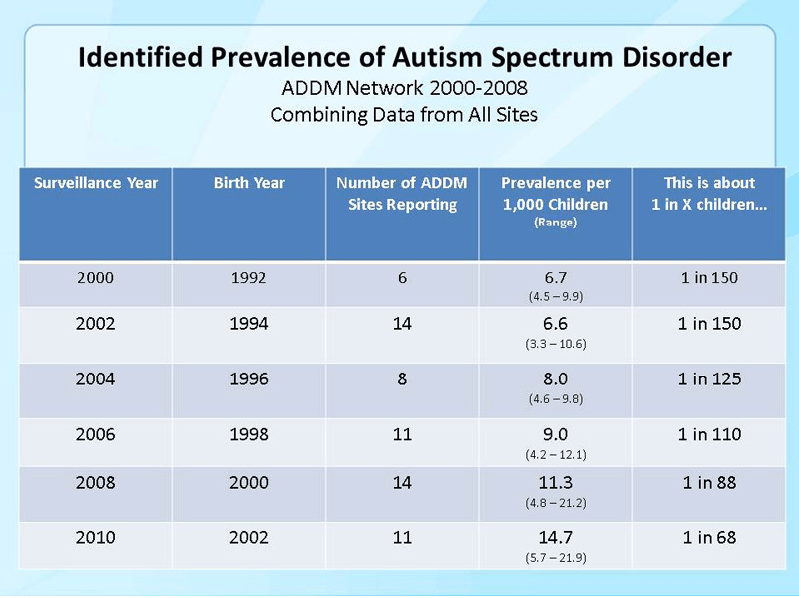For years, researchers have struggled to understand the spike in instances of autism, believing that genetics alone could not account for the worrisome trend. According to the US Centers for Disease Control and Prevention, autism is becoming an increasingly common disorder, with 1 in every 150 children born with the condition in 1992 growing to 1 in every 68 born in 2002. This means that the chances for a child to be born with autism, a neurodevelopmental disorder that makes it difficult to socially interact and communicate with others, more than doubled in the span of a decade, and not necessarily due to an increased genetic propensity.
One explanation that was suggested for the rise in autism cases posits that environmental factors, such as pollution and air quality, could account for this unexplained phenomenon, but it is uncertain how and when such toxins take their effect. Now a new study examines the connection between exposure to air pollution and incidences of autism, showing that this association is particularly strong when a woman is exposed to toxins in the third trimester of pregnancy. Raanan Raz, a visiting scientist at the Harvard School of Public Health, explained the new perspective he took in examining the connection, and what can be done to control autism, and other possible pollution-induced disorders.
Narrowing down the parameters to understand the trend
In an observational study, Raz and principle investigator in the study Marc Weisskopf collected data on pregnant women’s exposure to fine particulate matter across the United States, dating back to 1989. To clarify, fine particulate matter, also known as PM2.5, is made up of liquid droplets or solid particles in the air that measure less than 2.5 micrometers in diameter, such as those found in smoke or haze. Raz tells NoCamels that fine particulate matter is important in this case because, “due to their small size, they are capable of getting deep into the human lungs and from there, some of them may even get into the bloodstream.”
SEE ALSO: The Upside Of Suburbia: Green Spaces Found To Significantly Increase Child’s Birth Weight
Of the 116,000 pregnant women Raz and his team collected data from, 245 of the resulting children were born with autism. In order to understand whether the environmental conditions during pregnancy influenced the chances of contracting autism, the autistic group was compared to a group of 1,522 developmentally sound children. In addition, air quality data collected from the US Environmental Protection Agency was used to record the mothers’ environments before, during and after the pregnancy.
Raz’s resulting discovery may be a breakthrough in understanding the spike in autism cases of late; he found that exposure to high levels of fine particulate matter during the third trimester of a woman’s pregnancy, or weeks 29-40 and through to the due date, increased a baby’s risk of being born autistic. According to Weisskopf, “Our data adds additional important support to the hypothesis that maternal exposure to air pollution contributes to the risk of autism spectrum disorders.”
Women in urban and industrial areas face biggest risk
So in which kinds of areas are we more exposed to harmful particulate matter according to the research? Raz suggests that pregnant women in their third trimesters should avoid dense urban areas and industrial zones: “While PM2.5 exists naturally (from sources like natural dust, forest fires or sea water), human combustion of fossil fuels, such as coal, natural gas or oil-based power plants, vehicle engines, and various industry activities, all generate additional PM2.5. Another source for PM2.5 is human combustion of biomass. Urban and industrial areas are usually exposed to higher levels of PM2.5.”
Sign up for our free weekly newsletter
SubscribeIf you are or know a very pregnant truck driver or city dweller don’t call her up in a fret just yet. This is an epidemiological study and the theory, connecting air pollution to a higher risk for autism, remains causal, according to Raz. However, there is reason to believe that Raz’s and other researchers’ assertions regarding the link bear truth: “It is very difficult to study the mechanism of action of harmful exposures in humans, and autism is not a disorder we see in animals,” Raz explains. “One hypothesis, though, is that the effect of air pollution on the fetus is mediated by processes of inflammation. This hypothesis gets support from various studies that present links between brain inflammation in utero and autism, and from studies, mostly in animals, which show that PM2.5 is capable of causing immune responses in the brain.”
Raz: It is important to lobby our governments for regulation
Due to the lack of biological evidence for the link between air pollution and autism, Raz is not ready to rest on his laurels. “We are currently running several studies that are expected to shed additional light on the link between air pollution and autism, the largest one being in Israel. We expect to have additional results from these studies that will point to which air pollutants and emission sources are more relevant to the effect in utero and during which pregnancy weeks.”
Narrowing down the data will make it easier for researchers to assert a clear connection, but Raz reiterates that strictly observational research won’t prove anything and that there is need for definitive biological tests. Yet he is confident that air pollution can be singled out as the culprit in the rise of autism cases, reminding us that scientists have already discovered that air pollution causes early death, lung cancer, heart disease and other grave health issues.
SEE ALSO: Can iPad’s Improve Autistic Kids’ Social Skills?
In another recent Israeli study, conducted at Tel Aviv University, researchers found a clear link between high exposure to air pollution and an increases risk for congenital malformations in babies, or serious physical defects. It was the first study to look into the possible association between different modes of conception, spontaneous conception (SC) and assisted reproductive technology (ART), as they relate to air pollution, finding that infants conceived through the latter method had a higher risk for birth defects when exposed to air pollution.
At the end of the day, Raz wants expecting mothers to be aware of risk they expose their baby to living in a densely polluted area during pregnancy, and for the public to rally governments for effective environmental policies. “In order to lower the risk of autism, and other diseases, from air pollution, one must reduce the exposure to air pollution, especially during pregnancy. The most effective way to do that is through public policy, and we hope that this study, along with others, will help to convince policy makers to take actions in order to reduce ambient air pollution levels as low as possible.”
Photos: CDC/ Nora Tam/ Ola Pemberton
Related posts

Israeli Medical Technologies That Could Change The World

Harnessing Our Own Bodies For Side Effect-Free Weight Loss

Missing Protein Could Unlock Treatment For Aggressive Lung Cancer






Facebook comments